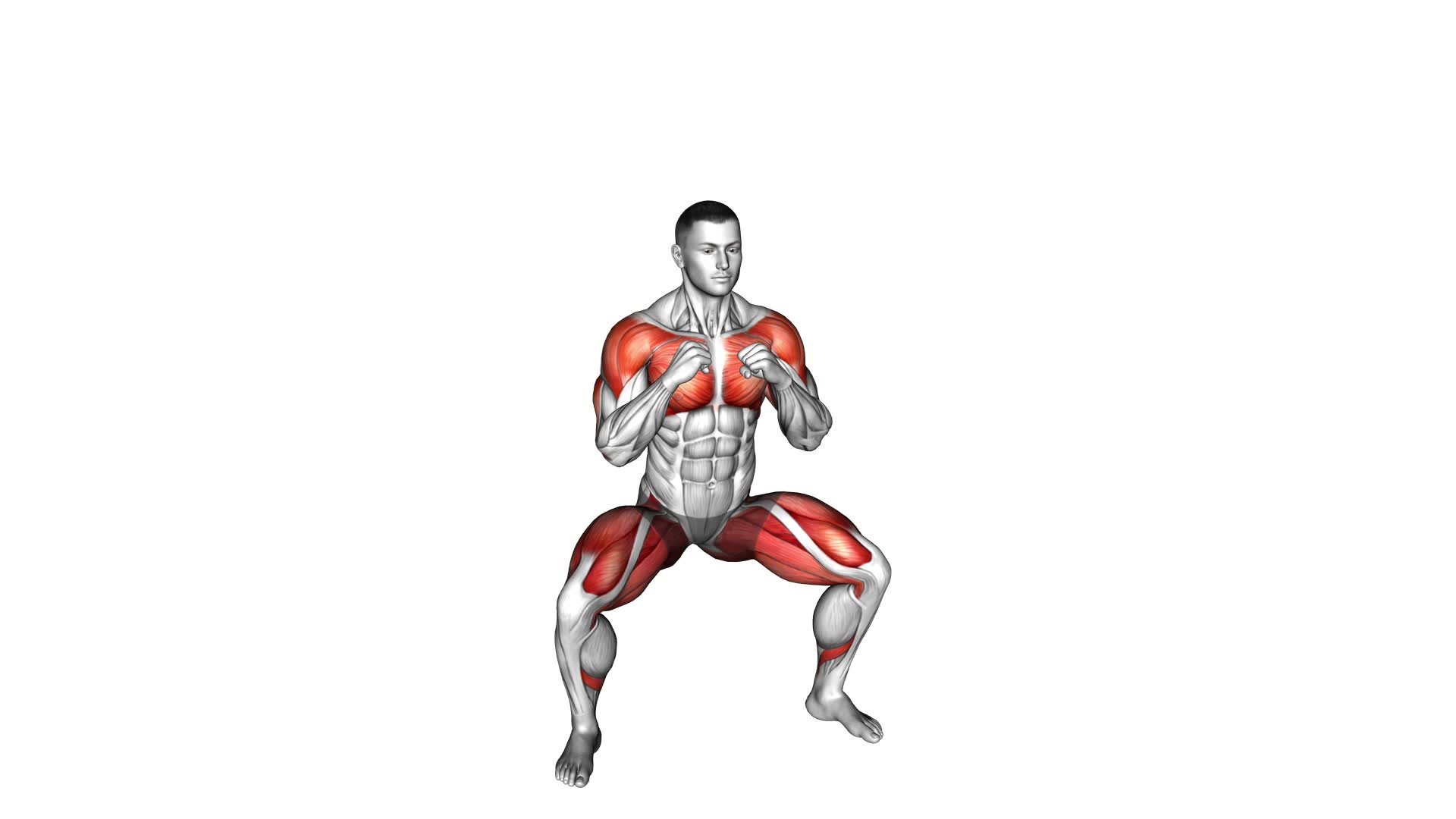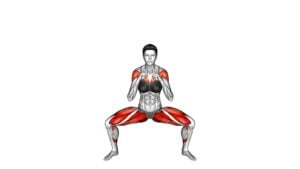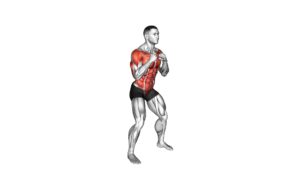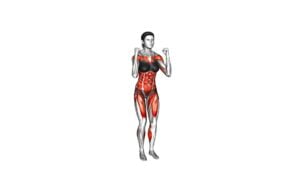Top Bottom Punch Squat (male) – Video Exercise Guide & Tips

Are you looking for a challenging and effective exercise to target your lower body and boost your punching power?
Watch This Exercise Video
Look no further than the Top Bottom Punch Squat!
This video exercise guide and tips will show you the proper form and technique to maximize your results.
With variations and modifications available, you can tailor this workout to your fitness level.
Avoid common mistakes and increase the intensity of your workout with expert tips.
Get ready to take your fitness to the next level with the Top Bottom Punch Squat!
Key Takeaways
- Targets multiple muscle groups (glutes, quads, hamstrings)
- Builds muscle and increases leg strength
- Works core muscles for improved stability and balance
- Enhances athletic performance
Benefits of the Top Bottom Punch Squat
Discover the numerous benefits of incorporating the Top Bottom Punch Squat into your workout routine. This exercise targets multiple muscle groups, making it an efficient and effective addition to any fitness regimen.
One of the key benefits of the Top Bottom Punch Squat is its ability to strengthen and tone your lower body. By engaging your quadriceps, hamstrings, and glutes, this exercise helps to build muscle and increase overall leg strength.
In addition to its lower body benefits, the Top Bottom Punch Squat also works your core muscles. The punching motion engages your abs and obliques, leading to improved stability and balance. This exercise can also help to improve your overall athletic performance, as it mimics movements commonly used in sports and activities that require explosive power and quick reflexes.
To perform the Top Bottom Punch Squat with proper technique, start by standing with your feet shoulder-width apart and your hands in a boxing position. As you lower into a squat, imagine punching an imaginary target in front of you, extending your arms as you rise back up. Remember to keep your back straight, chest lifted, and knees aligned with your toes throughout the movement.
Incorporating the Top Bottom Punch Squat into your workout routine can provide a wide range of benefits, including increased leg strength, improved core stability, and enhanced athletic performance. Give it a try and experience the positive effects for yourself.
Proper Form and Technique for the Top Bottom Punch Squat
To perform the Top Bottom Punch Squat with proper form and technique, it's crucial to pay attention to your foot placement. Placing your feet shoulder-width apart and slightly turned outwards will provide a stable base and allow for proper alignment during the exercise.
Additionally, it's important to avoid common form mistakes such as letting your knees collapse inwards or rounding your back, as these can lead to injury and compromise the effectiveness of the exercise.
Foot Placement Importance
You need to pay attention to your foot placement when performing the Top Bottom Punch Squat to ensure proper form and technique. Proper foot placement techniques are crucial for maximizing the benefits of this exercise.
When starting the squat, position your feet shoulder-width apart and slightly turned outwards. This stance provides a stable base and allows for proper alignment of your knees and hips.
As you lower into the squat, ensure that your weight is evenly distributed on both feet, with your heels firmly planted on the ground. This will help engage your glutes, quadriceps, and hamstrings effectively.
Additionally, maintaining a neutral arch in your feet and avoiding excessive inward or outward rolling will prevent unnecessary strain on your joints.
Common Form Mistakes
Avoid leaning too far forward during the Top Bottom Punch Squat, as this can compromise your form and hinder the effectiveness of the exercise. One of the most common form mistakes is allowing your upper body to lean excessively forward, putting unnecessary strain on your lower back and reducing the engagement of your glutes and quads.
To maintain proper form, focus on keeping your chest up and your back straight throughout the movement. Engage your core muscles to stabilize your spine and prevent excessive forward lean.
Another tip for proper technique is to ensure that your knees are tracking in line with your toes, without caving inward or pushing too far forward.
By avoiding these common form mistakes, you can maximize the benefits of the Top Bottom Punch Squat.
Now, let's explore variations and modifications for this exercise.
Variations and Modifications for the Top Bottom Punch Squat
Try incorporating different types of resistance, such as dumbbells or resistance bands, to add variation to your Top Bottom Punch Squat workout. By introducing these modifications, you can target different muscle groups and challenge your body in new ways. Here are four variations and modifications you can try:
- Dumbbell Top Bottom Punch Squat: Hold a dumbbell in each hand, with your arms bent at a 90-degree angle. As you perform the squat, punch one arm forward, then switch and punch the other arm forward on the way up. This adds an upper body element to the exercise, engaging your shoulders and triceps.
- Resistance Band Top Bottom Punch Squat: Attach a resistance band to a sturdy anchor point, and hold the handles in each hand. As you squat, pull the resistance band towards your chest, then push it away as you stand back up. This variation adds resistance to the movement, targeting your back and biceps.
- Medicine Ball Top Bottom Punch Squat: Hold a medicine ball in front of your chest as you perform the squat. As you stand back up, extend your arms forward and punch the medicine ball away from your body. This variation increases the core engagement and challenges your balance.
- Jumping Top Bottom Punch Squat: Instead of standing up straight after each squat, explode off the ground and jump as high as you can. As you land, immediately go into the next squat. This modification adds plyometric training to the exercise, increasing power and explosiveness.
Now that you have learned about various variations and modifications for the Top Bottom Punch Squat, let's move on to the next section where we'll discuss common mistakes to avoid.
Common Mistakes to Avoid When Performing the Top Bottom Punch Squat
To ensure proper form and maximize the effectiveness of the Top Bottom Punch Squat, it's important to be aware of common mistakes that should be avoided. One common mistake isn't maintaining proper alignment of the knees and toes. When performing this exercise, make sure your knees are tracking in line with your toes to prevent unnecessary strain on the joints. Another mistake to avoid is rounding your back or hunching your shoulders. This can lead to poor posture and increase the risk of injury. Instead, keep your back straight and your shoulders pulled back throughout the movement.
It is also important to avoid rushing through the exercise. Take your time and focus on performing each repetition with control and precision. This will help to engage the targeted muscles and prevent injury. Additionally, be mindful of the depth of your squat. Going too low can put excessive strain on the knees, while not going low enough may limit the effectiveness of the exercise.
While the Top Bottom Punch Squat is a great exercise for targeting the lower body and core, it's important to be aware of the pros and cons. One advantage is that it engages multiple muscle groups, including the glutes, quads, and hamstrings. However, it may not be suitable for individuals with knee or lower back issues. In such cases, alternative exercises like lunges or step-ups can be considered.
In the next section, we'll discuss tips for increasing the intensity of your top bottom punch squat workout. By avoiding common mistakes and incorporating these tips, you can make the most out of this exercise and achieve your fitness goals.
Tips for Increasing the Intensity of Your Top Bottom Punch Squat Workout
To increase the intensity of your Top Bottom Punch Squat workout, consider incorporating resistance bands into your routine. These bands provide added resistance, challenging your muscles and helping to build strength.
Additionally, adding plyometric movements, such as jump squats or squat jumps, can help to increase the intensity and explosiveness of your workout.
Incorporating Resistance Bands
To increase the intensity of your Top Bottom Punch Squat workout, incorporate resistance bands. Resistance bands are a great way to add an extra challenge to your routine and target different muscle groups.
Here are four tips for incorporating resistance bands into your workout:
- Attach the resistance band to a sturdy anchor point, such as a squat rack or door frame.
- Place the resistance band just above your knees to engage your glutes and hip muscles during the squat movement.
- As you perform the squat, focus on maintaining tension in the resistance band throughout the entire range of motion.
- To further intensify your workout, try performing plyometric movements, such as squat jumps or lateral jumps, with the resistance band.
Adding Plyometric Movements
To increase the intensity of your Top Bottom Punch Squat workout even further, incorporate plyometric movements into your routine.
Plyometric exercises involve explosive movements that can help improve your power and strength. By adding plyometric movements to your workout, you'll challenge your muscles in new ways and enhance your overall athletic performance.
Some examples of plyometric exercises that can be incorporated into your Top Bottom Punch Squat routine include squat jumps, box jumps, and tuck jumps. These exercises require you to generate maximum force in a short amount of time, which can lead to increased muscle power and improved cardiovascular fitness.
By combining these explosive movements with the Top Bottom Punch Squat, you can create a dynamic and effective workout that targets multiple muscle groups.
Now, let's move on to a sample workout routine that incorporates the Top Bottom Punch Squat.
Sample Workout Routine Incorporating the Top Bottom Punch Squat
You should include the Top Bottom Punch Squat as part of your sample workout routine. This exercise is a compound movement that targets multiple muscle groups, making it an effective addition to any workout plan.
Here is a sample workout routine that incorporates the Top Bottom Punch Squat:
- Warm-up: Start with five minutes of light cardio, such as jogging or jumping jacks, to get your blood flowing and muscles warmed up.
- Top Bottom Punch Squat: Perform three sets of 10-12 repetitions. Make sure to maintain proper form throughout the exercise, keeping your back straight and core engaged.
- Upper Body Exercise: Pair the Top Bottom Punch Squat with an upper body exercise, such as push-ups or dumbbell rows. Perform three sets of 10-12 repetitions for each exercise.
- Lower Body Exercise: Finish off your workout with another lower body exercise, such as lunges or deadlifts. Again, aim for three sets of 10-12 repetitions.
By incorporating the Top Bottom Punch Squat into your sample workout routine, you can enjoy the benefits of compound exercises while targeting multiple muscle groups.
Remember to listen to your body and adjust the weights and repetitions as needed. Stay consistent with your workouts and gradually increase the intensity to see progress over time.
Frequently Asked Questions
How Many Calories Does the Top Bottom Punch Squat Burn?
The number of calories burned during a top bottom punch squat can vary depending on factors such as your weight, intensity, and duration of the exercise. While the exact number can't be determined without these specifics, it's important to note that the top bottom punch squat is a compound exercise that engages multiple muscle groups.
This can lead to an increase in calorie burn compared to isolated exercises. Additionally, the top bottom punch squat offers modifications and various benefits for improving strength, stability, and cardiovascular fitness.
Can I Do the Top Bottom Punch Squat if I Have Knee or Back Problems?
If you have knee or back problems, you may need to consider alternative exercises or modifications for the top bottom punch squat.
It's important to prioritize your safety and avoid exacerbating any existing issues.
Consult with a fitness professional or physical therapist who can provide guidance on suitable exercises that won't put strain on your knees or back.
They can help tailor a workout routine that suits your specific needs and helps you achieve your fitness goals.
How Often Should I Incorporate the Top Bottom Punch Squat Into My Workout Routine?
To incorporate the top bottom punch squat into your workout routine, start by determining your fitness level. Beginners can modify the exercise by performing it without weights or using a chair for support.
Aim to do this exercise 2-3 times a week, gradually increasing the intensity as you get stronger.
Adding the top bottom punch squat to your HIIT workout can boost endurance, strengthen your lower body, and improve overall cardiovascular fitness.
Can the Top Bottom Punch Squat Help Improve My Sports Performance?
The top bottom punch squat can definitely help improve your sports performance. It's a dynamic exercise that targets multiple muscle groups, enhancing your power, explosiveness, and overall strength.
However, it's important to note that the top bottom punch squat may have limitations for certain athletes, such as those with joint issues or specific movement restrictions.
Additionally, variations and modifications of the exercise can be made to cater to different sports, ensuring optimal results for your specific athletic needs.
Is It Necessary to Use Weights While Performing the Top Bottom Punch Squat?
Using weights while performing the top bottom punch squat isn't necessary, but it can provide additional benefits.
It's essential to focus on using proper form for the exercise to maximize its effectiveness.
Adding weights can increase the resistance and challenge your muscles, leading to improved strength and muscle development.
However, it's crucial to start with lighter weights and gradually increase the load to avoid injury and ensure proper technique.
Conclusion
In conclusion, the top bottom punch squat is a highly effective exercise for strengthening the lower body and improving overall fitness.
By following proper form and technique, you can maximize the benefits of this exercise and avoid common mistakes.
Additionally, incorporating variations and modifications can help keep your workouts challenging and prevent plateaus.
Remember to listen to your body and gradually increase the intensity of your top bottom punch squat routine for optimal results.

Author
Years ago, the spark of my life’s passion ignited in my mind the moment I stepped into the local gym for the first time. The inaugural bead of perspiration, the initial endeavor, the very first surge of endorphins, and a sense of pride that washed over me post-workout marked the beginning of my deep-seated interest in strength sports, fitness, and sports nutrition. This very curiosity blossomed rapidly into a profound fascination, propelling me to earn a Master’s degree in Physical Education from the Academy of Physical Education in Krakow, followed by a Sports Manager diploma from the Jagiellonian University. My journey of growth led me to gain more specialized qualifications, such as being a certified personal trainer with a focus on sports dietetics, a lifeguard, and an instructor for wellness and corrective gymnastics. Theoretical knowledge paired seamlessly with practical experience, reinforcing my belief that the transformation of individuals under my guidance was also a reflection of my personal growth. This belief holds true even today. Each day, I strive to push the boundaries and explore new realms. These realms gently elevate me to greater heights. The unique combination of passion for my field and the continuous quest for growth fuels my drive to break new ground.







